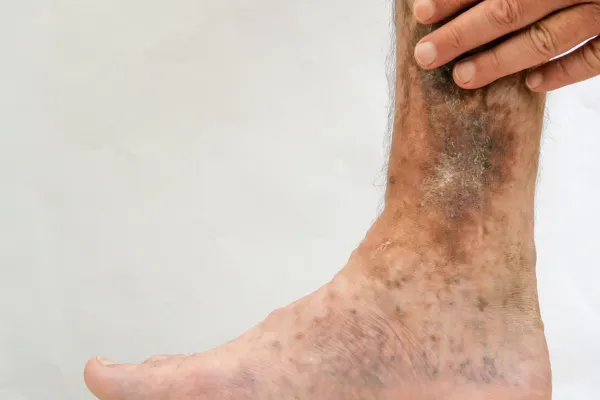
Early Treatment for Venous Leg Ulcers: Why It’s Critical for Healing
Venous leg ulcers are a common yet serious medical condition, characterized by open sores on the legs that result from poor blood circulation. Often occurring just above the ankle, these ulcers can be painful, slow to heal, and prone to infection. Left untreated, they can lead to significant complications such as severe infections, cellulitis, and even permanent tissue damage. Early intervention is crucial to prevent these outcomes and to facilitate effective healing.
In this comprehensive guide, we will explore the causes and symptoms of venous leg ulcers, discuss why early treatment is essential, and provide an overview of the various treatment options available. Whether you are managing a venous ulcer yourself or caring for a loved one, understanding the importance of prompt treatment can make a significant difference in healing outcomes.
For more detailed information on treating venous leg ulcers, visit our [Comprehensive Ulcer and Wound Care in Chicago] blog post at the American Surgeon Group.
Causes of Venous Leg Ulcers
Venous leg ulcers develop due to a condition called chronic venous insufficiency (CVI), in which the veins in the legs are unable to properly return blood to the heart. Normally, veins have one-way valves that help direct blood flow back toward the heart. In cases of venous insufficiency, these valves become weakened or damaged, allowing blood to flow backward and pool in the lower legs. This pooling increases pressure in the veins and surrounding tissues, eventually leading to skin breakdown and the formation of ulcers.
Key factors contributing to venous leg ulcers include:
Age: As people age, the risk of venous insufficiency and ulcers increases.
Obesity: Excess weight puts additional pressure on the veins in the legs, contributing to poor circulation.
History of Deep Vein Thrombosis (DVT): Previous blood clots in the legs can damage the valves in the veins, making it more difficult for blood to return to the heart.
Prolonged Sitting or Standing: Jobs or lifestyles that require long periods of standing or sitting can increase the risk of venous insufficiency due to decreased circulation.
Genetics: A family history of varicose veins or other circulatory problems can increase the likelihood of developing venous ulcers.
Symptoms of Venous Leg Ulcers
Recognizing the early signs of a venous leg ulcer is crucial for timely treatment. The symptoms of venous ulcers often develop gradually, beginning with mild discomfort and swelling, which may be mistaken for less severe conditions. However, as the ulcer progresses, the symptoms can become more pronounced and difficult to manage.
Common symptoms of venous leg ulcers include:
Swelling in the Lower Legs: Chronic venous insufficiency leads to fluid buildup in the legs, causing noticeable swelling, particularly around the ankles and lower calf.
Itchy, Flaky Skin: The skin surrounding a venous ulcer may become dry, irritated, and itchy due to poor circulation and skin damage. This may result in scratching, further damaging the skin and exacerbating the risk of ulcer formation.
Open Sores: As the skin breaks down, open sores or wounds develop. These ulcers typically appear red, shallow, and may ooze clear or yellowish fluid. In severe cases, the wound may become deep, exposing the underlying tissue.
Discoloration Around the Ulcer: The skin surrounding the ulcer often appears discolored, with a brownish or reddish tint. This discoloration is a result of blood pooling in the area, leading to leakage of red blood cells into the tissues.
Hardened or Tight Skin: Over time, the tissue around the ulcer may become hardened or scarred, a condition known as lipodermatosclerosis. This thickening of the skin can make the area feel tight and uncomfortable.
Pain or Discomfort: While some individuals may not feel significant pain, many experience aching or a sense of heaviness in the affected leg, especially after long periods of standing or walking.
Why Early Treatment Matters
The sooner a venous leg ulcer is treated, the better the chances of preventing complications and promoting faster healing. Delaying treatment can lead to a host of serious problems, including:
Infection: Open ulcers are highly susceptible to bacterial infection. If bacteria enter the wound, they can cause cellulitis (a painful skin infection) or even more severe systemic infections, which can be life-threatening if left untreated.
Chronic Wounds: Without prompt intervention, venous leg ulcers can become chronic, meaning they fail to heal within the typical 4 to 6 weeks. Chronic ulcers are not only more difficult to treat, but they also carry a higher risk of complications.
Tissue Damage and Necrosis: As the ulcer deepens, it can damage the surrounding skin and tissue. In severe cases, tissue death (necrosis) can occur, leading to even more complex medical interventions, such as surgical removal of the dead tissue or, in extreme cases, amputation.
Reduced Mobility: Venous ulcers can cause significant pain and discomfort, which may lead to reduced mobility. Over time, this immobility can worsen circulation problems and increase the risk of additional ulcers forming.
Psychological Impact: Living with a venous ulcer can also take a toll on mental health, leading to feelings of frustration, anxiety, and depression, especially when healing is delayed. Early treatment can improve the patient’s quality of life by reducing pain and speeding up the healing process.
Treatment Options for Venous Leg Ulcers
Effective treatment of venous leg ulcers requires a comprehensive approach that addresses both the ulcer itself and the underlying venous insufficiency. Here are the most common treatment options:
1. Compression Therapy
Compression therapy is considered the gold standard for treating venous leg ulcers. It involves applying pressure to the legs using specialized compression bandages, stockings, or wraps. This pressure helps improve blood flow, reduce swelling, and promote healing by encouraging blood to move from the lower legs back toward the heart.
Compression bandages are often used initially to reduce swelling and provide a stable environment for the ulcer to heal.
Compression stockings may be prescribed once the ulcer has started to heal to maintain good circulation and prevent recurrence.
Consistent use of compression therapy is crucial for managing venous insufficiency and preventing future ulcers from developing.
2. Wound Debridement
Wound debridement is the process of removing dead, infected, or damaged tissue from the ulcer. Debridement helps create a clean environment for the wound to heal and prevents infection from spreading. There are several methods of debridement, including:
Surgical Debridement: A healthcare provider uses surgical instruments to carefully remove necrotic tissue.
Autolytic Debridement: This method uses the body’s natural enzymes to break down dead tissue. Special dressings are applied to the ulcer to facilitate this process.
Enzymatic Debridement: Enzymes are applied to the wound to dissolve dead tissue and encourage the growth of healthy tissue.
Debridement is often performed in conjunction with other treatments, such as compression therapy and advanced wound dressings.
3. Advanced Wound Dressings
The type of dressing used on a venous ulcer can have a significant impact on the healing process. Advanced wound dressings are designed to maintain a moist environment, protect the wound from infection, and promote faster healing. Some common types of advanced wound dressings include:
Hydrocolloid Dressings: These dressings form a gel-like substance when they come into contact with wound exudate, creating a moist environment conducive to healing.
Foam Dressings: Foam dressings are absorbent and are often used for ulcers that produce a lot of fluid.
Antimicrobial Dressings: Dressings containing antimicrobial agents, such as silver or iodine, help reduce the risk of infection.
4. Surgical Interventions
In severe cases, surgery may be required to treat venous leg ulcers. Surgical options are typically considered when conservative treatments are ineffective, or when there is significant tissue damage or deep infection. Some common surgical interventions include:
Skin Grafts: Skin grafts involve taking healthy skin from another area of the body and placing it over the ulcer to promote healing.
Vein Surgery: For patients with chronic venous insufficiency, vein surgery may be recommended to improve blood flow in the legs. This could involve procedures such as vein stripping or ablation to close off damaged veins and reroute blood flow through healthier veins.
Prevention of Venous Leg Ulcers
While treatment is essential, preventing venous leg ulcers from recurring is just as important. Prevention strategies include:
Wearing Compression Stockings: Even after the ulcer has healed, wearing compression stockings can help improve blood flow and prevent future ulcers.
Maintaining a Healthy Weight: Losing excess weight can reduce pressure on the veins and improve circulation.
Exercising Regularly: Gentle exercises, such as walking or leg raises, can help improve blood flow and strengthen the muscles in the legs.
Avoiding Prolonged Sitting or Standing: Take breaks to move around if your job or lifestyle requires long periods of sitting or standing.
Conclusion
Venous leg ulcers are a serious medical condition that require prompt and effective treatment to prevent complications and promote healing. Early intervention is key to reducing the risk of infection, chronic wounds, and other severe outcomes. By understanding the causes and symptoms of venous leg ulcers and seeking timely care, patients can significantly improve their chances of successful healing.
At American Surgeon Group, we specialize in comprehensive venous ulcer care. If you or a loved one is dealing with a venous leg ulcer, don’t wait—contact us today for expert treatment and personalized care. Early intervention can make all the difference in your healing journey.
